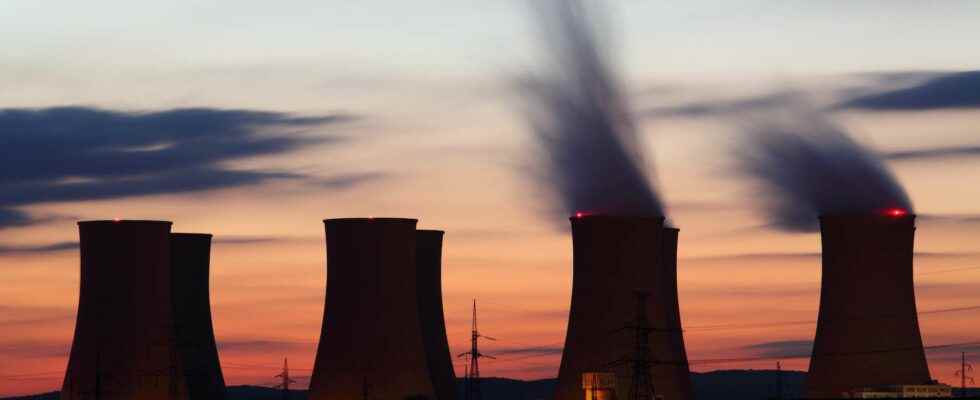In France, nuclear energy provides approximately 75% of our electricity. If several levels of reactors are present, the basic technology remains the same: they are all pressurized water reactors. But how do they actually work?
You will also be interested
[EN VIDÉO] The difference between nuclear fusion and nuclear fission What is the difference between fission and nuclear fusion? Both involve reactions at the atomic nucleus, but fusion involves bringing two light nuclei together, where fission breaks a heavy nucleus into two lighter ones.
France generates three quarters of its electricity thanks tonuclear energyused since the 1950s. Today there are 56 reactors spread over 18 nuclear center across the country that provide nearly 400 terawatt hours (TWh). The principle is the same as for any so-called thermal power plant: electricity is produced from a source of heat.
In the case of theenergy nuclear, heat is created by nuclear reactions which take place in the reactor vessel, which corresponds to what is also called the reactor core. In France, the technology used is based on a combustible in the form of pencils, surrounded by water liquid under pressure : all the reactors are PWRs (for pressurized water reactors). The water contained inside the reactor vessel, which surrounds the combustibleis there at a very high temperature, around 300°C, so that at atmospheric pressure it would be in the form of vapour. But within the “primary circuit”, which conveys the heat created by the fissions to a “secondary” circuit which exploits this heat, the water is maintained at a pressure of around 155 barsalmost 155 times the atmospheric pressure ! This allows him to stay liquid.
If the tank seems very small in this diagram, it is she who contains all the heat which is then extracted, from the top of her 12 meters high! It is then connected to the “GV” or generators of steam, which are approximately 20 meters high: the water in the tank, heated by the fuel, circulates to the steam generator, where it transmits its heat to the water which was already contained therein. But without ever touching it, in order to avoid any radioactive contamination. Everything is done by passing interposed pipes, as in the illustration: the water from the steam generator vaporizes after being heated (hence the name), and turns a turbine… which generates ‘electricity ! There are three or four cooling loops in a reactor, that is to say three or four sets of steam generator + all the elements around. Only the tank and the pressurizer (which maintains the pressure at 155 bars) are unique.
If we look on a smaller scale: the tank, irreplaceable!
As said above, it is the vessel of the nuclear reactor which contains all the heat. Let’s take a closer look at its components:
It is one of the irreplaceable components of reactors, and above all the most valuable. the nuclear fuel is there in the form of rods approximately four meters high, assembled within fuel assemblies that contain between 250 and 300 rods depending on the type of reactor. The guide tubes of the control rods make it possible to control the chain reaction : fissions cause other fissions, and so on. The goal is to obtain a fission for another, that is to say a stable power. The tubes thus make it possible to guide the absorbent clusters they contain, which, as their name suggests, absorb neutrons. They also stiffen the structure of the assembly. The water circulation takes place as shown in the diagram: the “cold” water, which returns from the steam generators, is reintegrated and circulates between the assemblies. It heats up on contact with the fuel rods, then exits the other side and returns to the steam generators.
And on an even smaller scale: the nuclear reactions in the vessel
But how is heat created by fuel rods? This is where fission comes in! The pencils are made of oxideuranium and sometimes from plutonium in the form of pellets assembled one above the other, and covered with a sheath in alloy of zirconium. Different isotopes uranium or plutonium are contained, some of which are said to be “fissile”: when a neutron at their nucleus, the latter becomes unstable, and splits into two lighter nuclei, called “fission products”. But fission is not just the splitting of a nucleus in two. During the reaction, neutrons are emitted instantaneously, in addition to the two lighter nuclei resulting from fission. These neutrons will then collide with other fissile nuclei, and so on. But there are also what are called “delayed neutrons”: they result from the radioactive decay of fission products, and can also cause fissions.
When the reactor is started up, a source of neutrons is used: it enables the chain reaction to start, which then maintains itself and thanks to continuous checks in the reactor. Heat, on the other hand, is created primarily by thekinetic energy particles placed in movement by fission reactions. In addition, water slows down neutrons, which collide with it and thus transmit heat. Finally, the fission products are often themselves radioactive, and release energy during their decay, in particular byepisode of gamma rays.
Interested in what you just read?
